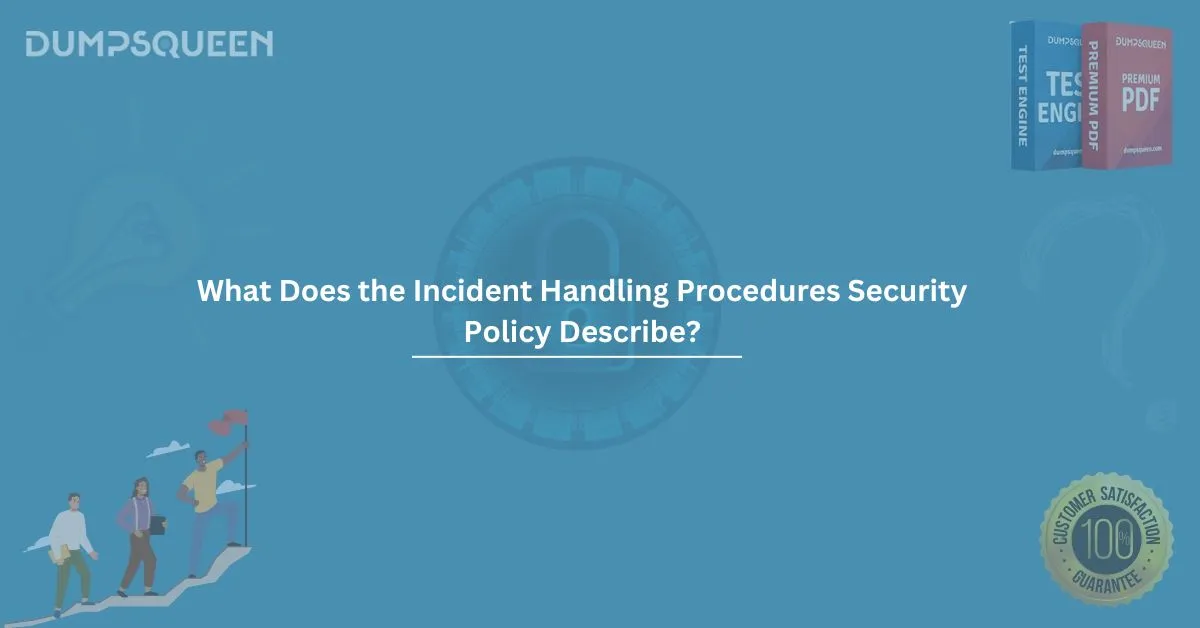In the world of cybersecurity, organizations are constantly exposed to threats ranging from phishing and malware to insider attacks and data breaches. The effectiveness of a company’s defense doesn’t rely solely on firewalls and antivirus software—it heavily depends on well-defined incident handling procedures.
So, what does the incident handling procedures security policy describe? At its core, this policy outlines how an organization detects, responds to, manages, and recovers from security incidents. It is an essential component of an organization's overall information security policy framework, designed to minimize damage, reduce recovery time, and preserve evidence for potential investigations.
This article explores the full scope of what the incident handling procedures security policy entails, why it's important, and how it aligns with broader security strategies in any enterprise environment.
Introduction to Incident Handling Procedures
Before diving into what the policy describes, it’s vital to understand what incident handling is. Incident handling refers to the steps and processes an organization follows when a cybersecurity event, or incident, occurs. These events could include:
- Unauthorized access to systems or data
- Malware infections
- Ransomware attacks
- Denial-of-service (DoS) attacks
- Data leakage
- Insider threats
The incident handling policy ensures that when these situations arise, there’s a consistent, timely, and effective method in place to manage them.
What Does the Incident Handling Procedures Security Policy Describe?
Let’s explore the answer to our main question in detail.
A. Roles and Responsibilities
The first thing the policy describes is who does what. It defines:
- Incident Response Team (IRT) structure
- Specific roles like Incident Handler, Forensic Analyst, Communication Officer, etc.
- Reporting hierarchy and communication channels
Clarity of responsibility is critical in high-pressure situations. The policy ensures all team members know their duties during an incident.
B. Incident Classification and Prioritization
Not all incidents are equal. The policy outlines:
- Types of incidents (low, medium, high impact)
- How to classify an event as an incident
- How to prioritize response based on risk assessment
This helps avoid overreaction to minor issues and ensures critical threats are handled with urgency.
C. Detection and Reporting Procedures
The policy includes:
- How to monitor systems and networks for anomalies
- Indicators of compromise (IoCs)
- How employees should report suspected incidents
- Logging and alert mechanisms
Having a detection protocol increases the chance of catching incidents early before they escalate.
D. Response Procedures
Perhaps the most critical section, the policy describes:
- Initial response actions
- Containment strategies (short-term and long-term)
- Communication protocol (internal & external)
- Use of forensic tools to analyze the threat
It offers a step-by-step playbook for security teams to control the situation.
E. Recovery and Restoration
The policy outlines:
- Procedures to remove malware, patch vulnerabilities, and restore systems
- How to validate the integrity of restored systems
- Timeline for service recovery
- Coordination with IT support teams
The focus here is on minimizing downtime and ensuring the return to normal business operations.
F. Post-Incident Activities
Handling doesn’t end after recovery. The policy ensures organizations:
- Conduct a lessons learned meeting
- Create a post-incident report
- Implement preventative controls
- Train staff based on incident insights
This cycle helps in continuous improvement of security infrastructure.
G. Legal and Regulatory Considerations
It describes how to:
- Preserve digital evidence
- Maintain chain-of-custody
- Comply with laws like GDPR, HIPAA, or PCI-DSS
- Report to law enforcement or regulators, if necessary
Why Is This Policy Important?
A. Minimizes Business Disruption
A documented and practiced procedure ensures faster response and reduced downtime, helping businesses maintain continuity.
B. Reduces Financial Loss
Data breaches and downtime are costly. Rapid handling reduces the impact on finances, reputation, and operations.
C. Helps with Compliance
Regulatory bodies often require a formal incident response plan. This policy ensures your organization remains compliant.
D. Enhances Cybersecurity Maturity
With every incident, organizations improve. Having a solid policy fosters a resilient, security-aware culture.
Core Elements of a Good Incident Handling Policy
To better understand what the incident handling procedures security policy describes, here’s a breakdown of its must-have elements:
|
Element |
Description |
|
Policy Statement |
High-level overview of purpose and scope |
|
Scope |
What systems, data, and users it applies to |
|
Definitions |
Clarification of key terms like “incident,” “breach,” etc. |
|
Roles & Responsibilities |
Who is responsible for what |
|
Procedures |
Step-by-step guide to detection, response, recovery, reporting |
|
Communication Plan |
Internal and external communication protocol |
|
Training Requirements |
Frequency and format of awareness training |
|
Policy Review |
How often the policy is reviewed and updated |
Best Practices for Implementing Incident Handling Policies
Implementing a policy is as important as writing it. Here are best practices:
- Get Executive Support: Buy-in from leadership ensures resources and authority.
- Test the Plan: Run tabletop exercises and simulations regularly.
- Keep It Updated: Revise the policy annually or after every major incident.
- Train Staff: Employees are the first line of defense—keep them informed.
- Document Everything: From initial detection to resolution, documentation is key.
Real-Life Incident Examples and Lessons Learned
Example 1: Target Data Breach
- Incident: Attackers stole data from 40 million credit cards.
- Cause: Network credentials stolen via third-party HVAC vendor.
- Lesson: Incident handling policy must include third-party risk and detection.
Example 2: Maersk Ransomware Attack
- Incident: NotPetya ransomware disrupted Maersk’s operations worldwide.
- Loss: $300 million
- Lesson: Recovery strategies like offline backups and tested disaster recovery plans are critical.
These cases show how a well-executed policy can reduce impact—or how the lack of one can cause major losses.
Incident Handling Lifecycle: Based on NIST Framework
The NIST Computer Security Incident Handling Guide (SP 800-61 Rev. 2) outlines a four-phase lifecycle:
- Preparation
- Detection and Analysis
- Containment, Eradication, and Recovery
- Post-Incident Activity
Most incident handling policies are structured around this lifecycle to ensure consistency and completeness.
Sample Multiple Choice Questions (MCQs)
Question 1:
What does the incident handling procedures security policy primarily describe?
A. Network configuration settings
B. Backup management procedures
C. Steps to detect, respond, and recover from security incidents
D. Employee salary distribution policies
Answer: ✅ C
Question 2:
Which phase involves the identification of potential security threats?
A. Recovery
B. Preparation
C. Detection and Analysis
D. Post-Incident
Answer: ✅ C
Question 3:
Why is defining roles and responsibilities important in the policy?
A. To ensure salary increases
B. To identify who to blame
C. To ensure clarity during incident response
D. To avoid writing documentation
Answer: ✅ C
Question 4:
What framework does NIST recommend for incident handling?
A. ISO 9001
B. ITIL
C. SP 800-61 Rev. 2
D. HIPAA
Answer: ✅ C
Final Thoughts
Understanding what does the incident handling procedures security policy describe is crucial for anyone involved in IT governance, cybersecurity, or risk management. It’s not just a document—it's a blueprint for resilience, recovery, and long-term security.
At DumpsQueen, we recognize how vital cybersecurity knowledge is for IT professionals. Whether you're preparing for certifications like CompTIA Security+, CISSP, or CISA, mastering incident handling principles will set you apart.
Limited-Time Offer: Get an Exclusive Discount on the SEC504 Exam Dumps – Order Now!




